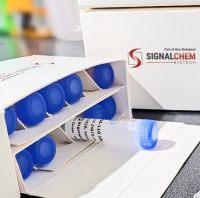In Vivo Footprinting and DNA Affinity Chromatography for Analysis of p53 DNA Binding Ability
互联网
650
p53 is a sequence-specific DNA binding protein. The p53 consensus is two copies of 5′-RRRC(A/T)(T/A)GYYY-3′. The interaction of p53 with specific DNA binding sites (DBS) has been analyzed extensively using electrophoretic mobility shift analysis (EMSA). These studies do not address the interaction of p53 with nuclear chromatin or the stability of p53-DBS interactions. In vivo footprinting examines the dynamic interactions of p53 protein in nuclear chromatin. p53 DBS affinity chromatography compares the stability of p53 from different cellular extracts with different DBS. Isogenic strains expressing high p53 levels, and deleted for p53, are required for controlled experiments using both methods. Different systems can be used to generate sufficient p53 protein (including DNA damage), and this results in the analysis of different forms of p53. A comparison of different cellular sources of high levels of p53 (in the presence and absence of DNA damage) vs different p53 DBS is required to appreciate the complexity of the regulation. Methods for comparing p53 from three different cellular sources with different DBS are presented here. The p53 research community needs to expand this analysis to complete the picture of how p53 differentially regulates transcription of target genes in nuclear chromatin.









